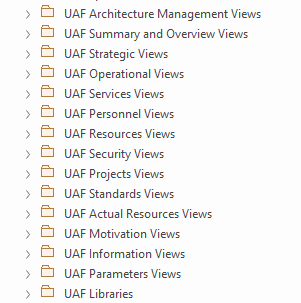| Prev | Next |
Introduction to the Unified Architecture Framework (UAF)
Welcome to the Unified Architecture Framework, fully integrated with Enterprise Architect. The tool not only supports all of the framework and language features, including productivity features, but also provides a collaboration platform that will allow architects, systems engineers, testers and other stakeholders from management down to implementation and support teams to view and contribute to the architecture and the value it brings to the organization.
The Unified Architecture Framework (UAF) 1.2 is a comprehensive modeling standard that enables architects and systems engineers, managers and other stakeholders to create precise, standardized representations of complex enterprises and systems. As an Object Management Group (OMG) standard, UAF supports the development of architectural descriptions across commercial industries, government agencies, and defense organizations, offering a Model-Based Systems Engineering (MBSE) approach to describing enterprise-level systems. Designed to handle architectures that span hardware, software, data, personnel, and facilities, UAF 1.2 is particularly valuable for organizations managing multi-domain, highly integrated challenges.
About the Unified Architecture Framework (UAF)
The Unified Architecture Framework (UAF) 1.2, developed by the Object Management Group (OMG), is a robust modeling standard designed to capture the full spectrum of enterprise architectures across commercial, government, and industrial domains. It addresses diverse needs, including business, operational, and system-of-systems integration. UAF provides a structured set of rules and concepts that enable the creation of consistent, semantically rich architecture models. These models act as comprehensive repositories from which modelers can create multiple tailored views.

UAF supports a wide range of applications, from enterprise and mission architecture to system-of-systems and cyber-physical systems engineering, and plays a key role in digital transformation initiatives. It is also compatible with established defense frameworks, such as the Department of Defense Architecture Framework (DoDAF) and NATO Architecture Framework (NAF). By aligning with ISO/IEC/IEEE 42010:2011, UAF ensures its architectural descriptions meet international standards while also serving as the successor to DoDAF, capable of automatically generating DoDAF-compliant views alongside numerous other valuable perspectives.
The designers intentionally designed the framework to be accessible not only to enterprise architects and systems engineers but also to executives, managers, and decision-makers who must interpret, manage, and oversee complex architectures.
Value and Benefits
The Unified Architecture Framework (UAF) 1.2 was created to close the communication gap between business leaders and technical professionals involved in enterprise architecture. The language is accessible not only to enterprise architects, systems engineers, and Information technology engineers but also to executives and enterprise managers who sponsor and guide such initiatives. By defining standardized ways to represent enterprise architecture, UAF enables stakeholders to concentrate on their areas of concern while still maintaining awareness of the overall enterprise context. This ensures that both technical implementers and business decision-makers can collaborate effectively through a shared architectural language and visualization framework. Some of the key benefits and value of the framework inlcude:
Improved Traceability and Decision Support
UAF strengthens traceability across domains, enabling decision-makers to follow requirements from high-level enterprise goals down to detailed implementation. This ensures mission components operate in alignment and provides enterprise managers, program managers, and executives with better oversight and strategic consistency.
System-of-Systems Modeling for Engineers
The framework supports consistent modeling of complex system-of-systems (SoS), bridging enterprise-level architecture with detailed design and implementation. This makes it particularly valuable for systems engineers and architects working on large, interconnected systems spanning multiple domains and organizations.
Rapid Adoption for Experienced Teams
For teams already familiar with UAF, the framework offers a minimal learning curve, allowing architects and engineers to quickly adapt to new roles or projects. Unlike adopting an entirely new modeling language, UAF enables teams to begin delivering value immediately with little additional training.
Accessibility for All Stakeholders
UAF specifications are designed to be clear not only to enterprise and systems architects but also to executives, sponsors, and program managers. This broad accessibility fosters collaboration and ensures that stakeholders at all levels can engage meaningfully in architectural discussions.
Standards-Based Tool Interoperability
By supporting both SysML-based tools and those aligned with other standards, UAF enhances interoperability across diverse modeling environments. This benefits tool users, integrators, and cross-functional teams that rely on exchanging architecture information across different platforms.
Integrated Security and Risk Management
UAF embeds security, risk, and compliance considerations into its modeling approach, covering the full lifecycle from design through implementation. This helps security architects, risk managers, and compliance officers define consistent SoS architectures that address threats and apply effective mitigation strategies.